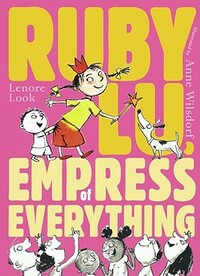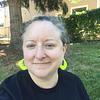Take a photo of a barcode or cover
My soon to be second grade daughter and I read Ruby Lu, Empress of Everything by Lenore Look together. Ruby Lu is Chinese-American, and her cousin Flying Duck's family has recently emigrated from China and her family is leaving with Ruby's while they get adjusted and Flying Duck's parents find jobs. This book has lots of great lessons for kids. It teaches them about immigration and what it's like to move to a new country. It also provides great examples of diversity with multiple races represented in the characters. And, Flying Duck is deaf which is included as a story line, but not the main focus which I think helps take a disability and normalize it in the sense that "some kids can't hear and this is how we handle it, but it's just part of life". And, Ruby Lu is a real spitfire girl which I love in books for my daughters. That being said, my daughter is the exact target age of this book and she is a skilled reader, but I thought there were a lot of words way beyond this age group's comprehension level. I'm glad my daughter and I were reading this together, so that I could explain the meaning of the words to her and help her learn the pronunciation.
a multicultural chapter book for the younger set. this is book two in the series (i thought i’d read book one already, but now i can’t remember it) and ruby has to be a smile buddy for her newly immigrated cousin, flying duck, who happens to be deaf. what a great book! in a fun way, the author weaves together elements of chinese culture, deaf culture, and the hilarious antics of incorrigible ruby lu.
http://ginasblogging.blogspot.com/2007/06/ruby-lu-empress-of-everything-author.html
There's no mention of a sensitivity reader, but the author did use a Chinese Sign Language dictionary (though no info on which dictionary or when it was published).
Flying Duck (FD) has many skills, but her most impressive skill to the other children is that she can lipread.
Deafened at four from head trauma, FD, who is now about 8 years old, can speak and lipread Cantonese as well as some English, and signs Chinese Sign Language. It's unclear how deaf she is, but obviously a significant degree to be sent to the school for the deaf in Taishan.
For Ruby, “Having a cousin from China who was deaf was as good as having a cousin who had a third eye in the middle of her forehead.”
They (the neighborhood children) only like FD for the novelty, which quickly wears off and comes with problems such as (surprise, surprise) communication issues because everyone is speaking Cantonese rather than English. Ruby ends up studying Cantonese more, which helps.
Ruby gives little speeches during class explaining how to interact with deaf people (make eye contact before speaking, etc.). Among other tips, she says to call FD’s name first, suggesting FD has a certain level of residual hearing. Ruby is presumably tasked with this because FD cannot speak English fluently, even though she is in an English-speaking classroom with no apparent support services. She apparently does not wear hearing aids, does not have an aide like a certified deaf interpreter or a CSL-fluent interpreter to ensure she has access.
FD says “pay me” instead of “play with me,” and Ruby does all her homework, which suggests that she doesn’t speak or speechread much English, making it stand out even more to me that she lacks support in school. Indeed, she is failing and has to attend summer school. Honestly, the lack of support is completely realistic, especially for less affluent schools, which this seems to be. But it is extremely strange to me that the author would mention FD went to a deaf school in China, but mentions no linguistic accessibility now that she is mainstreamed in the US.
In summer school FD and all the other hearing children (mostly immigrants) take ASL classes, which is an exciting “secret language.” Unsure if it’s common for hearing people to think signs are a secret language or if this is a reference to Ann M. Martin’s book "Jessi’s Secret Language," which was a great big thumbs-down from me. Either way, annoying. (Why isn’t any spoken language a “secret language”?)
FD features surprisingly little in the book. She excels at everything she tries and any struggles she might have with communication is never brought up. Only Ruby's struggles to understand spoken Cantonese is touched on toward the beginning.
Deaf reader reviewing books with deaf characters. This book is listed on my ranked list of books with deaf characters: https://slacowan.com/2023/01/14/ranked-deaf-characters-in-fiction.
Very cute, yet meaningful and sweet. Great for early chapter book readers.
This book had so much humor while tackling all kinds of issues that would have bogged down other authors (deafness, immigration, ethnic life). The back matter is great.
I have to go back and read the first one now!
I have to go back and read the first one now!
In some ways this book seemed a bit too much like Ruby Lu, Brave and True, and sometimes felt like "more of the same." However, I really liked the way Lenore Look incorporated a person with a disability - a deaf cousin who is super cool in Ruby's eyes. Like Grace Lin's The Year of the Rat, immigration is also addressed at a level appropriate for young people.
Sometimes the stories in this book, as compared to those in Brave and True, seemed to be less well-meaning-but-misguided-behavior and maybe just a bit more straight up misbehavior - which made for less comfortable reading with Isabelle. I had to sort of explain away some actions, or use them as opportunities to teach: "Do you think that was good behavior?" I do think that an actual school-aged child reading this book on his/her own would find humor in Ruby's antics.
Sometimes the stories in this book, as compared to those in Brave and True, seemed to be less well-meaning-but-misguided-behavior and maybe just a bit more straight up misbehavior - which made for less comfortable reading with Isabelle. I had to sort of explain away some actions, or use them as opportunities to teach: "Do you think that was good behavior?" I do think that an actual school-aged child reading this book on his/her own would find humor in Ruby's antics.
Sort of an Asian Junie B. Jones. This does have a good message as Ruby Lu is pretty insightful for a 2nd grader.
This sequel to "Ruby Lu, Brave and True" follows Ruby Lu as she adjusts to life with her immigrant cousin, Flying Duck, who also happens to be deaf. I think that people who enjoy Junie B. Jones will also like Ruby Lu.
Appealing story about what Ruby does when her cousin Flying Duck's family immigrates to the US and moves in with Ruby. Flying Duck is deaf, and knows Chinese sign language, so Ruby becomes a Smile Buddy at school to help her adjust. It's a charming kid hijinks kind of story, but I found some of the narrative choppy. It felt like it leaps from adventure to adventure with very little transition.






